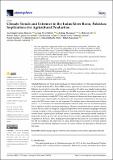Por favor, use este identificador para citar o enlazar a este item:
http://hdl.handle.net/10261/279938COMPARTIR / EXPORTAR:
 SHARE SHARE
 CORE
BASE CORE
BASE
|
|
| Visualizar otros formatos: MARC | Dublin Core | RDF | ORE | MODS | METS | DIDL | DATACITE | |

| Título: | Climate trends and extremes in the Indus river basin, Pakistan: Implications for agricultural production |
Autor: | Carrera Heureux, Ana Magali; Alvar-Beltrán, Jorge; Manzanas, Rodrigo CSIC ORCID; Ali, Mehwish; Wahaj, Robina; Dowlatchahi, Mina; Afzaal, Muhammad; Kazmi, Dildar; Ahmed, Burhan; Salehnia, Nasrin; Fujisawa, Mariko; Vuolo, Maria Raffaella; Kanamaru, Hideki; Gutiérrez, José M. CSIC ORCID | Palabras clave: | Climate change impacts Pakistan Extremes Food security Trend analysis Agriculture |
Fecha de publicación: | 2022 | Editor: | Multidisciplinary Digital Publishing Institute | Citación: | Atmosphere 13(3): 378 (2022) | Resumen: | Historical and future projected changes in climatic patterns over the largest irrigated basin in the world, the Indus River Basin (IRB), threaten agricultural production and food security in Pakistan, in particular for vulnerable farming communities. To build a more detailed understanding of the impacts of climate change on agriculture s in the IRB, the present study analyzes (1) observed trends in average temperature, precipitation and related extreme indicators, as well as seasonal shifts over a recent historical period (1997–2016); and (2) statistically downscaled future projections (up to 2100) from a set of climate models in conjunction with crop-specific information for the four main crops of the IRB: wheat, cotton, rice and sugarcane. Key findings show an increasing trend of about over 0.1 °C/year in observed minimum temperature across the study area over the historical period, but no significant trend in maximum temperature. Historical precipitation shows a positive annual increase driven mainly by changes in August and September. Future projections highlight continued warming resulting in critical heat thresholds for the four crops analyzed being increasingly exceeded into the future, in particular in the Kharif season. Concurrently, inter-annual rainfall variability is projected to increase up to 10–20% by the end of the 21st century, augmenting uncertainty of water availability in the basin. These findings provide insight into the nature of recent climatic shifts in the IRB and emphasize the importance of using climate impact assessments to develop targeted investments and efficient adaptation measures to ensure resilience of agriculture in Pakistan into the future. | Descripción: | This article belongs to the Special Issue Global Climate Change and Food Security: Recent Trends, Current Progress and Future Directions. | Versión del editor: | https://doi.org/10.3390/atmos13030378 | URI: | http://hdl.handle.net/10261/279938 | DOI: | 10.3390/atmos13030378 | E-ISSN: | 2073-4433 |
| Aparece en las colecciones: | (IFCA) Artículos |
Ficheros en este ítem:
| Fichero | Descripción | Tamaño | Formato | |
|---|---|---|---|---|
| climatepro.pdf | 2,55 MB | Adobe PDF |  Visualizar/Abrir |
CORE Recommender
SCOPUSTM
Citations
16
checked on 10-abr-2024
WEB OF SCIENCETM
Citations
15
checked on 28-feb-2024
Page view(s)
37
checked on 01-may-2024
Download(s)
26
checked on 01-may-2024
Google ScholarTM
Check
Altmetric
Altmetric
Este item está licenciado bajo una Licencia Creative Commons



